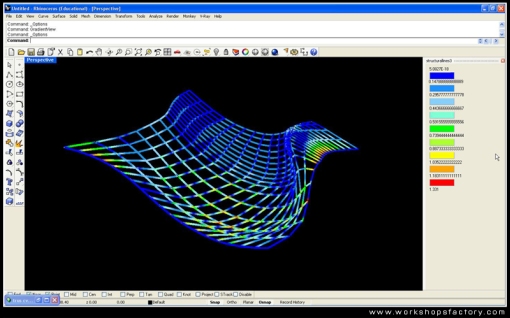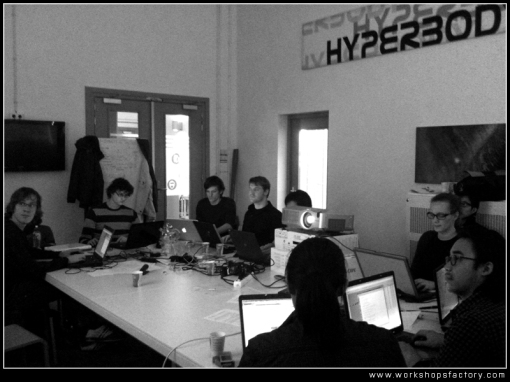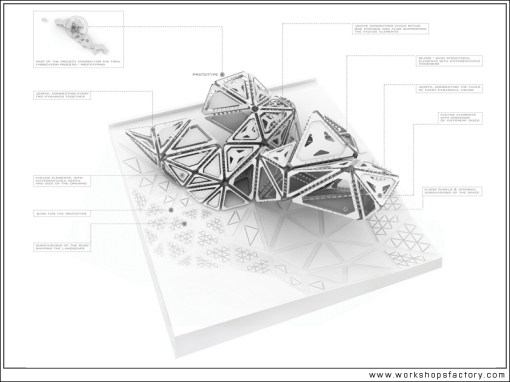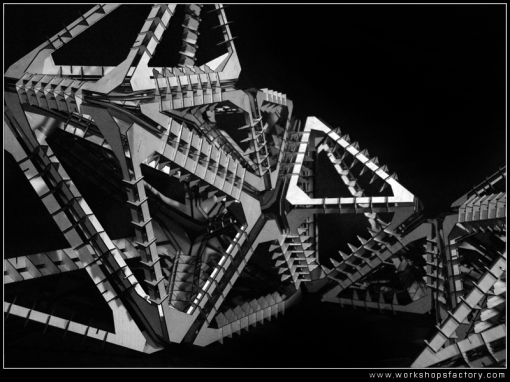Using c# with rhino and FORTRAN with Ansys I was able to create a FEA testing environment within Rhino. This enables the designer to get feedback on the proposed structural system allowing him to make changes during the conceptual phase of a design. This process does is not intended to replace the structural engineer by any means but rather provide information to better the design before ever approaching the engineer. The current plug-in evaluates stress and displacement for lattice structures using tube elements. Surface and solid interfaces are nearly completed and will be posed soon.
FEA analysis – plugin. Ansys + Rhino
28 03 2010Comments : 2 Comments »
Categories : Ansys, Erik Thorson
Ansys to Rhino
21 03 2010
This is a screen-shot of a rhinoscript I wrote while attending IaaC. This is a bi-product of the structural evolution project in my previous post. It allows one to view the results of an FEA test done in Ansys in Rhino. It also lets allows you to 3d print the results in color.
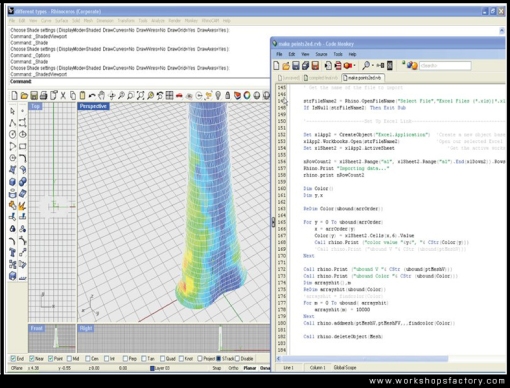
This was the first project I completed using Ansys and Rhino to create an evolutionary structure. I completed this in IaaC last year with Luis Fraguada of LaN
Comments : Leave a Comment »
Categories : Ansys, Erik Thorson, rhino scripting
Rhinoscripting Workshop in the Hyperbody Studio at the TU Delft – day03
9 03 2010In a 3rd day of the workshop we focused on developing computational techniques for digital fabrication. Students were were writing different scripts for unfolding and numbering processes and creating rib-structures out of any possible surface. The purpose of this session was to prepare students for making final prototypes of their msc3 studio design proposals. At the end all the participants could consult their studio project with all the tutors in terms of possible applications of Rhinoscripting.
Vodpod videos no longer available.We would like to thank TU Delft Hyperbody Studio for inviting us for this workshop (special thanks to dr. Nimish Biloria and Jelle Feringa) .
Comments : Leave a Comment »
Categories : Agata Kycia, generative design, Krzysztof Gornicki, rhino scripting, teaching
Rhinoscripting Workshop in the Hyperbody Studio at the TU Delft – day01/day02
5 03 2010In the beginning of March (01.03.2010-05.03.2010) WF’s Agata Kycia and Krzysztof Gornicki (with Han Feng) tutored a rhinoscripting/grasshopper workshop in the Hyperody Studio at the TU Delft. The workshop was a part of Msc3 master program and its purpose was to introduce generative techniques to the students. Thus during first days we started with a theoretical introduction to parametric/generative design and introduction to Visual Basic syntax. Next we worked on examples of generative processes which can be applied for architecure and design.
Comments : Leave a Comment »
Categories : Agata Kycia, generative design, Krzysztof Gornicki, rhino scripting, teaching
The Interwoven Systems Project – final prototype
1 03 2010A part of the form of the Interwoven Systems Project (done in the Hyperbody Studio / TU Delft) was chosen for final prototyping in 1:25 scale. The aim of the prototype was to test structural and formal aspects of the project, as well as the accuracy of the generative procedure, which combines both scripting and digital fabrication techniques.
All the structural beams and joints were laser cut out of 2mm plywood. However facade elements were made following completely different process. First of all we did three dimensional molds by 3-axis CNC milling, and then based on them we vacuum formed all the cups.
The diagram above shows which part of the final form of the project was chosen for the prototyping. Moreover it visualizes and describes all the elements of the coming prototype. All the pictures below present the final prototype with vacuum formed facade elements.
Because of the fact that we were able to vacuum form just a couple of plastic facade parts, for the rest of the model we fabricated elements by laser cutting 1mm white cardboard.
More information about the Interwoven Systems Project you can here (process of generating elements and fabrication process) and there (form finding simulation and final visualization).
Comments : Leave a Comment »
Categories : Agata Kycia, CNC milling, digital fabrication, generative design, Krzysztof Gornicki, laser cutting, rhino scripting, vacuum forming
